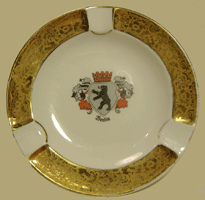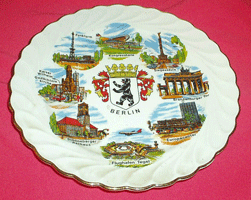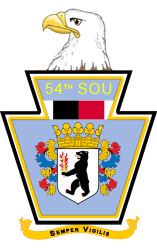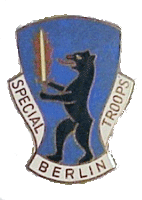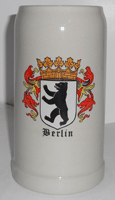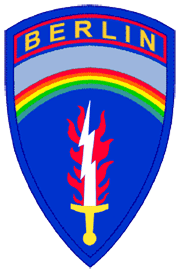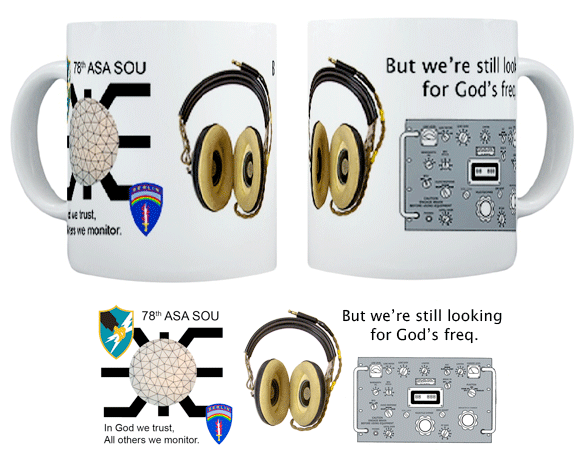Prior to the organization of Field Station Berlin in 1967, there were a number of Army Security Agency (ASA) units in Berln.![]()
| This timeline is based on oral and written histories of people who were actual participants of the events described in it: for example the person who drove the first truck-mounted operations van up Tuefelsberg to conduct a site survey there, and was eventually chased off by the British MPs; a person who was involved with the negotiations with the British for permission to operate from Tuefelsberg; and numerous people who worked in truck-mounted operations vans located on Tberg, before the permanent buildings were constructed. |
• 1951
ASA’s presence in Berlin began in January 1951, when Detachment F relocated from Herzo Base on TDY status.
• 1952
Det F was followed by Det E in April 1952. In June 1952, the status of the Det changed from TDY to PCS, and the operation moved from tents into a real building.
• 1953
In 1953, Det E was renamed Det F. On 1 July 1953, Det C joined Det F in Berlin.
• 1954
In March 1954, Det B, Headquarters ASA, Europe was also established in Berlin, and Dets F and C were subordinated to it in September. They were joined by Det A, 302nd Communications Reconnaissance Battalion (CRB).
•1955
Two small ASA teams (Team 6 and Team 620J1) were added in 1955, and Det B, Headquarters ASA, Europe was reorganized as a provisional company.
Independently of all this, the 9539th TCU was reassigned to Berlin from Ft. Myer, Virginia on 1 November 1955.
• 1957
In January 1957, the 9539th was redesignated as the 260th ASA Detachment. On 15 October 1957, all these ASA elements were consolidated into the 280th USASA Company, and were headquartered at Andrews Barracks
• 1961
The 280th was redesignated as the 78th USASA Special Operations Unit (SOU) on 15 June 1961. The 78th first located mobile equipment on Teufelsberg in July 1961.
• 1963
Construction was begun on a permanent facility atop Teufelsberg in October 1963.
• 1966
All ASA assets from Site 1 and Site 2 were consolidated to Teufelsberg. Orders dated 1 June 1966 redesignated the 78th as the 54th Special Operations Unit (SOU).
Sandy Cook, an ASA officer with the mission at heart, relates: ASA Frankfurt (the ultimate flatlanders) wanted the unit in Berlin to be designated a Battalion, but LTC Silas Hardy and MAJ Leslie (Buddy) LaFon both screamed to high heaven that that would make us an “SOB”. I also remember that when LTC John Smith took command in August or September of ’66 he thanked Si Hardy for not sticking him and all of us with that moniker.
The heraldic elements are deployed on a keystone-shaped shield, crowned by an eagle couped looking to dexter. A keystone is the uppermost stone in an arch, upon which all the other stones of the arch depend. It is emblematic of the critical role that the 54th SOU plays in the production of intelligence. The American Eagle is the national bird and is a symbol of strength and alertness. It is a part of the heraldic insignia of the United States, The Army Security Agency—of which the 54th SOU is a part, The Central Intelligence Agency (CIA), and the National Security Agency (NSA). The Unit Designator (54th SOU) shares the cap of the keystone with the ribbon bar for the Army of Occupation Medal, which was awarded for service in Berlin between May 9, 1945 and October 2, 1990. A mantled coat of arms of the city of Berlin is modified to show the Berlin Bear brandishing the flaming lightning sword of military SIGINT. This is an allusion to the 54th’s embattled location in the Outpost of Freedom, Berlin. The same symbolism can be seen in the DUI for Berlin Special Troops. The mantled coat of arms is more often found on items produced for civilian use, such as ashtrays, decorative plates, and beer steins.
The insignia rest on the motto Semper Vigilis (Vigilant Always) the Latin motto of the Army Security Agency, which echoes Thomas Jefferson's declaration that "The price of freedom is eternal vigilance." Gold is symbolic of honor and high achievement. This DUI for the 54th was manufactured unofficially by someone in Berlin, and though never recognized by the Army, was widely distributed among members of the 54th. |
|
| • 1967 On 15 December 1967, the 54th SOU was redesignated the USASA Field Station Berlin. |
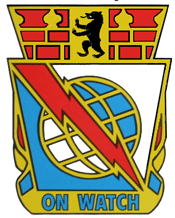 |
• 1972 The motto of the 26th SU (Immer Wachsam) is the German translation of the Latin motto of ASA: Semper Vigilis. |
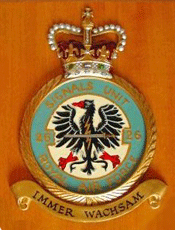 |
• 1975
During the summer, Site 4 operations were moved to Site 3 (Teufelsberg) as subsytem "Papa."
• 1977
The United States Army Security Agency (USASA) became the Intelligence and Security Command (INSCOM), and USASA FSB was redesignated the United States Army Field Station Berlin.
• 1991
The Field Station ceased operations on 2 December 1991.
The graphic reperesentation of all these units is captured in the designs below.
The shoulder patch for Berlin Brigade has been modified to create a specifically ASA Berlin patch. The flaming sword of the Berlin Brigade patch has been replaced by a flaming lightning sword to symbolize ASA's SIGINT role in Berlin. A lightning bolt is typically used in the insignia of ASA/INSCOM units. You can see this in the insignia for ASA (patch and DUI), Field Station Berlin, Field Station Rothwesten and INSCOM below:

The lightning bolt is also seen below in the obsolete collar brass for the Reserve Army Security Branch, which existed from 15 December 1952 to 1 July 1962, when it was merged with the Army Intelligence and Security Branch.
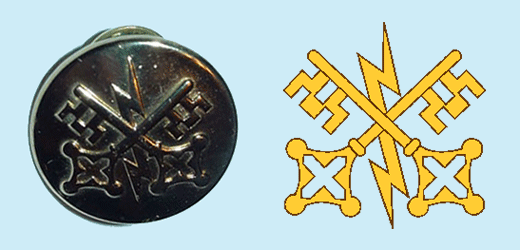
And in the the new (2012) branch of service insignia for Electronic Warfare pictured below.
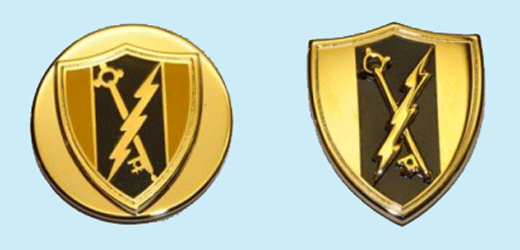
The alternate pre-Field-Station design shows the Berlin Brigade patch with the ASA "Lightning Fast Chicken Plucker" claw and lightning bolts.
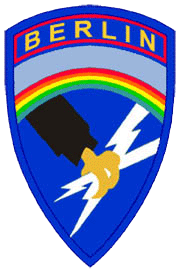
The 280th ASA Company T-shirt shop is open on Cafe Press.com.
The 78th ASA SOU was one of the many pre-Field-Station ASA units in Berlin. The “spider” emblem represents the operations building as it was then. The ASA shoulder patch—that nobody wore—is in attendance on the upper left. The shoulder patch for the 280th ASA Co is in attendance on the lower right. The motto "In God we trust, All others we monitor" adorns the front under the “spider.” On the back of the white shirts (sorry, no printing on the back of the dark shirts) is the corollary "But we're still looking for God's freq!" The zipped hooddies only have the "spider" design on the back.
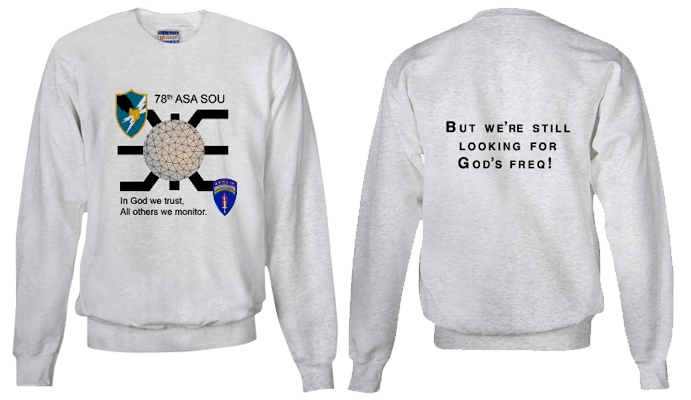 Click on the image above to go to the CafePress store where you can buy this or any of a number of other shirts with this design.
Click on the image above to go to the CafePress store where you can buy this or any of a number of other shirts with this design.
There is also a coffee mug for the 78th ASA SOU:
Click on the design above to go to CafePress to buy one.
To meet more old ASA-ers from the 78th, please visit: the Yahoo Group for the 78th ASA SOU. You have to sign-up to see what’s inside, but it’s worth it.
Designed by T.H.E. Hill
Follow me to the Field Station Berlin era.
While you're here, please take the time to follow the links below, look around the site, and get to know more about Voices Under Berlin: The Tale of a Monterey Mary and Berlin in Early Cold-War Army Booklets. The novel is ostensibly set against the backdrop of the Berlin Tunnel, but it is just as much about life at Field Station Berlin in the mid-1970s as it is about the Berlin Tunnel of the mid-1950s. If you were ever stationed at Field Station Berlin or at Marienfelde, or Herzo Base, or Rothwesten or Augsburg, then this one's for you.

